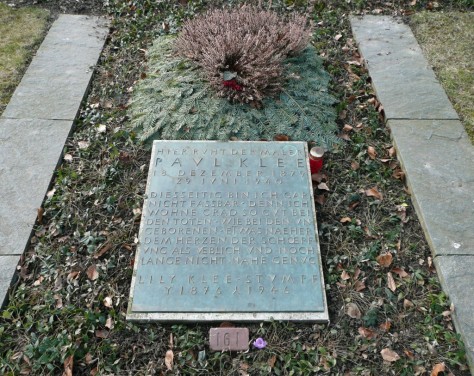
Diesseitig bin ich gar nicht fassbar
Denn ich wohne grad so gut bei den Toten
Wie bei den Ungeborenen
Etwas näher dem Herzen der Schöpfung als üblich
Und noch lange nicht nahe genug.
Ici-bas, je suis insaisissable.
Car je vis aussi bien parmi les morts que parmi les âmes à naître.
Un peu plus près du coeur de la création que l’ordinaire.
Et pourtant, bien trop loin encore
(Paul Klee’s epitaph Schosshalde Cemetery, near by the Zentrum Paul Klee, Bern)
“I cannot be grasped in the here and now. For my dwelling place is as much among the dead as the yet unborn. Slightly closer to the heart of creation than usual. But not nearly close enough”
These words by Paul Klee (1879-1940), were fist published in the catalogue of his first one-man exhibition at the Hans Goltz’s Gallery in Munich, in 1920. They became his epitaph on the gravestone, but for art critics, concentrated on this passage, they are a deepening of the sense of what it means to be an artist for Klee. It is a manifesto.
Why? What does it mean?
Klee is aware of the artist’s role, conceived as having a particular position. The artist lives on a threshold: the term he chooses “diesseitig” (on this side), indicates just a philosophical reading of his standing in the middle. Through the vision, the painter can draw on what is visible in the world, revealing, at the same time, the other side, the mysterious one, just invisible. His place is then moving along by balancing between what is done, what has a shape, the tradition (as well the ruins) and the opposite, what is yet unborn, the infinite possibilities.
The philosopher di Giacomo explained it very well:
“The proper place of Klee’s art is the boundary between the visible and the invisible, between the finished shape and the formation process ever to be performed: if the first term gives us objects that hide their sense, the second term gives that sense, not as something achieved once and for all, but as something that we must wonder about again and again. Klee’s painting is exactly raising a question.”(1)
That is why his work is a never-ending, infinite genesis, and for this reason never achieved, never close enough, but rather always in progress research, thanks to visitors’ gaze (attentiveness) called time after time to bring the work of art back to life.
(1) Giuseppe Di Giacomo, Icona e arte astratta, Aesthetica Preprint, Centro Internaz. Studi di Estetica, 1999, p.85
…………………………………………………………………………………………
L’EPITAFFIO DI KLEE
«Nell’al di qua non mi si può afferrare. Ho la mia dimora tanto tra i morti quanto tra i non nati. Più vicino del consueto al cuore della creazione, ma ancora non abbastanza vicino»
Questa famosa frase di Paul Klee (1879-1940) venne pubblicata, per la prima volta, nel catalogo della prima mostra personale, tenutasi nel 1920, nella Galleria di Hans Goltz a Monaco.
Talmente famosa da diventare l’epitaffio sulla sua tomba e da essere considerata dai critici d’arte una dichiarazione-manifesto sul senso più profondo dell’essere artista per Klee.
Perché? Cosa significano queste parole?
Klee è cosciente del ruolo dell’artista, che reputa in una posizione particolare. L’artista vive su una soglia: il termine che sceglie “diesseitig” (al di qua), indica proprio una lettura filosofica di questo “stare in mezzo”. Attraverso la visione, il pittore può attingere a ciò che è manifesto nel mondo, rivelandone, al tempo stesso il lato più misterioso, invisibile appunto. Il suo luogo è dunque muoversi sul crinale di ciò che è compiuto, ciò che ha una forma, la tradizione (ma anche la rovina) e ciò che invece non ce l’ha ancora, le infinite possibilità.
Il filosofo di Giacomo lo spiega egregiamente quando afferma:
“Il luogo proprio dell’arte di Klee è il limite tra il visibile e l’invisibile, tra la forma compiuta e il processo di formazione sempre da compiersi: se il primo termine ci dà oggetti che nascondono il loro senso, il secondo termine ci dà proprio quel senso, non però come qualcosa di raggiunto una volta per tutte, bensì come qualcosa su cui dobbiamo sempre e di nuovo tornare a interrogarci. La pittura di Klee è questa interrogazione”.(1)
Ecco allora che l’opera è una genesi continua, infinita e, proprio per questo, mai compiuta, mai abbastanza vicina, ma sempre in divenire grazie anche all’occhio dello spettatore chiamato a far rinascere di volta in volta l’opera.
(1) Giuseppe Di Giacomo, Icona e arte astratta, Aesthetica Preprint, Centro Internaz. Studi di Estetica, 1999, p.85
Consider the wider context of Klee’s epitaph by reading his 1927 lecture in Jena , On Modern Art.
One item that can take your life to the following degree!